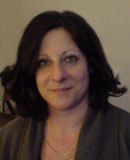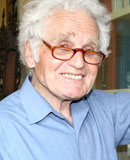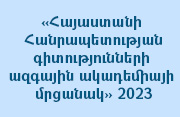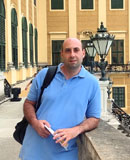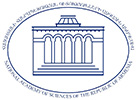 |
|||||||||||||||
|
|||||||||||||||
| General Page | About Academy | Divisions | Organizations | Members | Contact us |
|
|
|
 Science Development Foundation of NAS RA  All Armenian Foundation Financing Armenological Studies 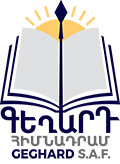 Geghard Scientific Analitical Fundation 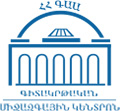 International Scientific Educational Center of NAS RA  Fundamental Scientific Library of NAS RA  International Commission for awarding Viktor Ambartsumian International Prize  Armenian National Information Point HORIZON 2020  EURAXESS-Armenia Portal   Academic Scientific Research Computer Network of Armenia |
News
|
Notices
On 15-19 October, 2024, we invite to take part in the 12th international symposium "Optics and its applications", which will be held in Yerevan (Armenia). The deadline of registration is August 15, 2024 From October 11-13, 2024, a pan-Armenian scientific conference on "Natural Sciences, Mathematics, Technology, Computer Science in the 21st century: problems of popularization and education and their solutions" will take place at the National Academy of Sciences of the Republic of Armenia On 16–17 September, 2024, the Institute of Literature after M. Abeghyan of the National Academy of Sciences of the Republic of Armenia, The Institute of World Literature after M. Gorky of the RF National Academy of Sciences invite you to participate in the international scientific conference dedicated to the 100th anniversary of the death of V. Bryusov which will take place in Yerevan On August 29–30, an international conference titled "Issues of Historical and Cultural Heritage in the Post-Soviet Period" will be held in the Round Hall of the National Academy of Sciences On July 12 , at 12:00 PM, in the Round Hall of the Presidium of the Armenian National Academy of Sciences (24 Baghramyan ave., Yerevan, Armenia), the presentation of the bilingual book by geographer and cartographer Rouben Galichian titled A Cartographic Examination of "Historical" Maps in the National Atlas of Azerbaijan, 2014 and the Invented Terminology of "Western Azerbaijan" will take place Международный инновационный центр нанотехнологий СНГ (МИЦНТ СНГ) при поддержке Межгосударственного фонда гуманитарного сотрудничества государств - участников СНГ (МФГС) и Объединенного института ядерных исследований объявляет о проведении конкурса на соискание грантов на разработку проектов в рамках деятельности МИЦНТ СНГ в 2024 году и очередной Стажировки молодых ученых и специалистов стран СНГ в Дубне в апреле - мае 2024года ՀՀ գիտության և տեխնիկայի զարգացման 2020-2024թթ. գերակայության ՀՀ կառավարության որոշման նախագիծ Publications in Press
|
 |
Website last updated on: 17:08, 26/07/2024 |  |
|
General Page
- About Academy
- Divisions
- Organizations
- Members
- Contact us
- Structure
- Presidium Members
|
|||||
|
© Copyright 1998-2024 All Rights Reserved. Website is created and supported by Academical Scientific Research Computer Network of Armenia (ASNET-AM) For any suggestions write to webmaster {[ at ]} sci.am |

![academy [@] sci.am academy [@] sci.am](images/email.jpg)





